Product Hub May 25, 2015
PVC: Print Very Carefully
The biggest apparel brands in the world are phasing out PVC inks – and putting plastisol’s future in question.
It was four years ago that Latitudes and plastisol parted ways. The Portland, OR-based screen printer didn’t have a choice. Nike had declared that all of its apparel decoration must be PVC-free, and the decorator – which does the majority of its printing for the sportswear giant – was told to follow suit.
Latitudes had roughly a year to replace plastisol. The decorator spent months researching and held multiple “PVC-Free Summits” to test its options. The owners of the shop even traveled to Europe to search for a solution. But when it came time to switch in November 2011, Latitudes didn’t have the luxury to slowly phase out plastisol. “Instead of a gradual ramp-up, we pretty much hit a wall and had to go straight into it,” remembers Production Manager Jamie McCrae. The screen printer immediately went from printing 50,000 impressions a day to 6,000. Adds McCrae: “It took us maybe three weeks to get back up to 70%.”
While the breadth of ink and equipment alternatives has improved since then, the task of replacing plastisol remains a giant headache. The equipment requirements are different (and costly to replace), the processes are more labor-intensive, and changing over is no mere flip of the switch. “A lot of people have an unrealistic timeline to make the change,” says Rob Coleman, segment marketing manager of textile screen inks for Nazdar SourceOne. “They think they can do it in a month or two. By and large, depending on the size of your shop and how much you’re investing, it will take probably 8-12 months.”
With so much difficulty involved, why are some of the largest screen printers in the country abandoning plastisol, the gold standard of user-friendly inks and the dominant ink chemistry in the United States? It’s because they don’t have a choice – and, perhaps at some point in the future, neither will you.
Turning Green
During the summer of 2011, Greenpeace launched a new campaign labeled “Detox.” At the center was an investigative report from the environmental organization that highlighted water pollution caused by the textile industry. Greenpeace singled out several global apparel brands, starting with Nike and Adidas, and called on them to clean up their practices. Six weeks after the campaign was launched, Nike announced it was “committed to the goal of zero discharge of hazardous chemicals by 2020.”
The prevailing perception is that Greenpeace’s campaign spurred Nike to eliminate PVC in all forms – including plastisol ink, which contains a PVC resin. But Greenpeace’s “Dirty Laundry” report at the time only mentions PVC fleetingly, and nowhere regarding apparel manufacturing or decoration.
The confusion underscores the complicated environmental profile of Polyvinyl Chloride (or PVC). Greenpeace and multitudes of other groups have urged manufacturers to phase the compound out of everything from electronics and toys to athletic shoes. PVC can contain phthalates and lead, and it releases toxic dioxins into the air if incinerated improperly.
And yet PVC is found in hundreds of everyday items – piping, insulation, flooring, blood bags and much more. In the case of plastisol, the PVC resin is encapsulated, and then fused to the garment. Because of that, when a garment is disposed, there is no runoff or migration, says Marci Kinter, vice president of government and business information for SGIA.
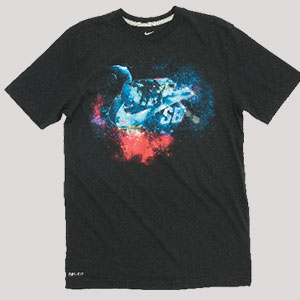
Latitudes (circle 126 on Free Info Card) used Hydra waterbase ink from Virus (circle 130 on Free Info Card) to create this vivid print.
“A lot of people have an unrealistic timeline to make the change from PVC.”
Rob Coleman, Nazdar SourceOne
While the saber rattling against phthalates the last few years reached a crescendo, by contrast the scrutiny of PVC has been a mere whisper. The Consumer Product Safety Improvement Act makes no mention of PVC. California’s Prop 65 regulates the presence of lead and phthalates in PVC, rather than limiting the amount of PVC in a product. “What we’re finding with the issues with PVC is that it’s very marketplace driven,” Kinter says. “It is not driven by any regulatory agency. Really, we see more issues with phthalates than the PVC.”
That was the case for Nike when it decided to replace plastisol. In 2010, Nike had introduced guidelines to “highlight ‘positive’ chemistries,” including PVC- and phthalate-free screen-printing inks. In its initial response to Greenpeace’s directive the following summer, Nike highlights its use of PVC-free ink as an example of its sustainability engagement, terming it “a major accomplishment for the apparel industry.”
And Nike isn’t the only one. According to Nazdar SourceOne, seven of the top 10 global apparel brands (including Zara, Adidas, Ralph Lauren and more) have partial or full PVC restrictions. That may affect a mere slice of decorators worldwide who work with those companies, but it also represents a significant volume of decorated garments. In short, the PVC initiative is surprisingly broad – and growing.
Because of that, “I can assure you on the ink side, that your big companies like Wilflex and Rutland are spending a significant portion of R&D on non-PVC technologies,” says Coleman. Plastisol alternatives may have been slim a few years ago, but the range of choices continues to improve. Rutland Plastic Technologies, for example, offers its EKO PVC-free plastisol (which uses an acrylic base), silicone ink and a variety of waterbase inks, including traditional and high solids acrylic (also known as rubber ink). The original EKO line was first developed in 2007, “but this last year has been the big year where it’s come forward and people have started really using it,” says Brian Lessard, print applications manager for Rutland.
Equipment manufacturers too have been forced to modify their offerings to accommodate these new inks. It was last fall at the SGIA show that M&R CEO Rich Hoffman, regarding new development, flatly declared: “We’re not even addressing plastisol anymore.” The company has developed a number of solutions to address two of the major issues with plastisol alternatives: the significant increase in necessary curing time, and the need to flash between each color. Among other products, at the show M&R unveiled the Sprint 3000T, a tri-level version of its dryer that offers 30 feet of belt travel within a footprint of a 12-foot-long chamber. “We have hundreds of customers that are large production shops, and they have their floors laid out around their equipment,” says David C. Zimmer, textile products manager for M&R. “You can’t simply tell the customer, ‘Sorry, but the new inks are going to require that you allow four times as much space for all your dryers.’ And they’re not going to re-layout their entire shops either if they can avoid it. We’re trying to offer them a solution that fits within the footprint they already have built in.”
Rethinking Ink
Last year, Nazdar SourceOne surveyed the major screen-printing ink manufacturers to predict ink sales over the next few years. According to the results, in 2014, 70% of the ink sold was to be comprised of PVC inks. In 2018, the survey predicted a decline to 45%.
Those numbers underscore two major conclusions regarding PVC ink. One is this: Plastisol will still be the primary ink used in North America. The vast majority of screen printers – those who cater to the promotional products industry, small businesses and the average everyday user – will still trade in plastisol. There will be no external pressure on them from their customers to make a switch for safety reasons. “ I think there’s always going to be a place for plastisol ink,” says Coleman.
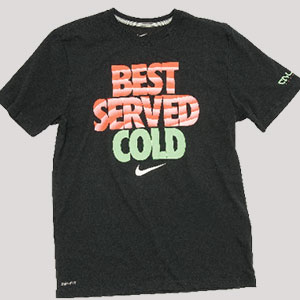
Special effects are possible with high opacity waterbase inks, like the Perfetto ink series from Virus (circle 130 on Free Info Card) and printed by Latitudes (circle 126 on Free Info Card).
The other conclusion: Traditional plastisol will still experience a dramatic decrease in usage. That change won’t occur without ramifications. When major brands champion an initiative, others tend to follow suit. Wal-Mart, for example, announced in 2007 that it was reducing or phasing out PVC in all of its products and packaging, yet does not ban PVC in apparel and still sells screen-printed garments with plastisol ink. “ If a major retailer decides to buy into this whole thing,” says McCrae, “ things will start moving pretty fast – much like the phthalate-free issue.”
The race to remove phthalates a few years ago highlights the wide-ranging aftershocks of regulation. Phthalates in children’s clothing and apparel decoration weren’t banned by product safety legislation, yet the scrutiny was so great that ink manufacturers were compelled to eliminate them from their formulations. Similar fallout can occur with PVC, either directly or indirectly as the result of regulation. Zimmer likens it to the switch from leaded to unleaded gasoline – a mandate from the government where many had not seen an environmental concern. “I have a feeling,” says Zimmer, “it may not be up to the printers in the long run to make that decision.”
And the truth is there are reasons beyond sustainable initiatives that are causing plastisol to dip. Traditional waterbase and discharge has become a leading method of decoration in retail, and it has driven customers to places like Forward Printing in Oakland, CA, which specializes in all things waterbase. Owner Dan Corcoran says none of his customers have mentioned PVC; they just want the soft-hand feel they see in retail. “ Waterbase is going to be pushed forward by a lot of fashion brands,” he says.
Whatever the reason, replacing inks that contain PVC will certainly be more difficult, but it can be done. “It’s not as bad as they think,” says McCrae. He lists a number of reasons: It’s easier for small, agile shops to make the switch compared to large shops with dozens of employees and presses; the durability requirements for prints from companies like Nike far exceed what the average buyer will want; and the level of knowledge and products out now surpasses what was available a few years ago.
“If a major retailer decides to buy into this whole thing, things will start moving pretty fast.”
Jamie McCrae, Latitudes
Despite all the hair-pulling, McCrae acknowledges that going PVC-free has made Latitudes a better shop. “ It turns out we weren’t really as good a printer as we thought we were,” he says. “This whole exercise has made us much better.”
Get Equipped
The needs for printing PVC-free ink can be radically different from standard plastisol procedures. These products from M&R (circle 118 on Free Info Card) highlight – and help solve – the biggest challenges.

Dryer PVC-free inks typically require 90 seconds of drying time compared to roughly 20 seconds for plastisol. The Sprint 3000T gas conveyor dryer offers 30 feet of belt travel in the space of a normal 12-foot dryer, creating the extra drying time to adequately cure these inks.
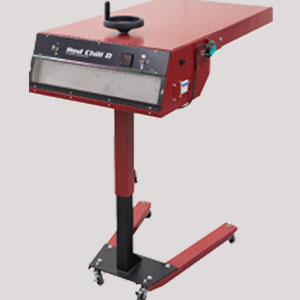
Flash Cure Unit The Red Chili Dflash cure unit uses versatile tungsten filament quartz lamps and works with both automatic and manual presses. M&R increased the air flow and included a substrate temperature sensor that automatically adjusts the flash time based on when the substrate hits the curing temperature.
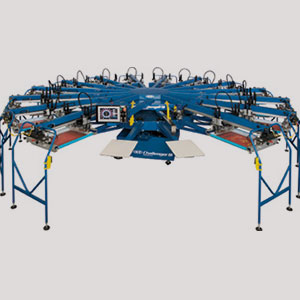
Automatic PressSince printing wet-on-wet is difficult with most PVC-free inks, one option is to expand the number of stations. The Challenger III automatic press offers 12-18 colors and 14-20 stations to handle the additional workload. It also features a squeegee dam system that prevents runnier waterbase inks from flooding back into the image area – a system featured on the majority of M&R’s presses.
Wearables
You Down with PVC Free?
is the absolute solution for all your fabrics,” says Rob Coleman of Nazdar SourceOne. The good news? Ink manufacturers are rapidly improving these alternatives, enabling them to be a valued part of your shop. Here are the four you need to be most familiar with.
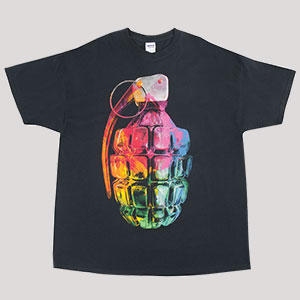
Traditional Waterbase/Discharge
Traditional waterbase inks feature water as the main solvent along with other co-solvents. It’s a retail favorite, particularly with discharge, where the dye of the fabric is essentially removed and often “re-dyed” with waterbase pigments.
- Little to no hand
- Popular look at retail
- Works well with high-nap fabrics
- Much easier cleanup than plastisol
- Won’t crack or peel
- Ideally suited for large prints
- Allows printing without underbase when using discharge activator
- Requires different emulsions than plastisol
- Longer curing times than plastisol
- May dry in screens in dry climate
- Very unforgiving with bad screen making
- Won’t print well on dark shirts unless discharge technique is used

High Solids Acrylic/Rubber Ink
Even though it’s a waterbase ink, high solids acrylic (HSA) prints more like a plastisol. It offers some of the best of both worlds – a softer hand than plastisol with greater opacity than traditional waterbase. Note that some formulations use polyurethane instead of acrylic.
- Prints similarly to plastisol; an easy transition for plastisol printers
- Cleans up with soap and water
- Bright opacity on dark fabrics (though may require double passing)
- Works very well on cotton
- Softer hand than plastisol and has a really nice stretch
- Better ability to mat down fibers compared to other non-PVC alternatives
- More expensive than traditional waterbase or plastisol
- Can dry in the screen and is difficult to use in low-humidity environments
- Doesn’t print wet-on-wet well, requires flashing after each color.
- Will print on any substrate, but less-than-satisfactory results on 100% polyester and some blends
- Longer cure times
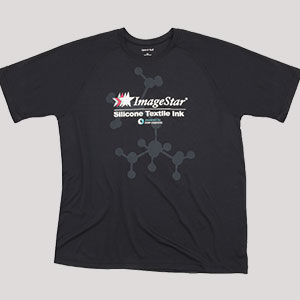
Silicone
With its superior stretchiness, silicone is quickly becoming an activewear favorite, even for customers who don’t have restrictions on PVC. Be forewarned though – that performance comes at a pretty penny.
- Exceptional stretch, making it ideally suited for performance wear
- No dye migration
- Good hand
- Cures quickly
- Shiny finish is best way to replace a plastisol gel print
- Requires a catalyst and thus will have a short pot life
- Much more expensive than plastisol or waterbase
- Won’t mat down fibers and thus performs poorly on cotton
- Won’t print wet-on-wet and requires flashing every color
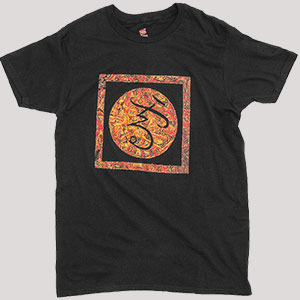
International Coatings (circle 127 on Free Info Card) created this print using its non-PVC non-phthalate plastiol 1811 AXEON Granite Base with foil treatment.
Most similar to plastisol in how it prints and performs. Won’t have to change setup or dry time
- Won’t dry in the screen
- Will work with any substrate
- Improved durability
- Won’t print wet-on-wet, and requires lots of flashing
- More expensive than plastisol
- Lacks the range of special-effect prints of plastisol
- Printers have reported inconsistent results in the past

Product Hub
Find the latest in quality products, must-know trends and fresh ideas for upcoming end-buyer campaigns.
